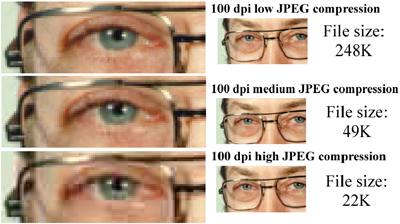

1. Basic Terminology
Key Concepts
digital
images
resolution
pixel dimensions
bit depth
dynamic range
file size
compression
file formats
COMPRESSION is used to reduce image file size for storage, processing, and transmission. The file size for digital images can be quite large, taxing the computing and networking capabilities of many systems. All compression techniques abbreviate the string of binary code in an uncompressed image to a form of mathematical shorthand, based on complex algorithms. There are standard and proprietary compression techniques available. In general it is better to utilize a standard and broadly supported one than a proprietary one that may offer more efficient compression and/or better quality, but which may not lend itself to long-term use or digital preservation strategies. There is considerable debate in the library and archival community over the use of compression in master image files.
Compression schemes can be further characterized as either lossless or lossy. Lossless schemes, such as ITU-T.6, abbreviate the binary code without discarding any information, so that when the image is "decompressed" it is bit for bit identical to the original. Lossy schemes, such as JPEG, utilize a means for averaging or discarding the least significant information, based on an understanding of visual perception. However, it may be extremely difficult to detect the effects of lossy compression, and the image may be considered "visually lossless." Lossless compression is most often used with bitonal scanning of textual material. Lossy compression is typically used with tonal images, and in particular continuous tone images where merely abbreviating the information will not result in any appreciable file savings.

Lossy Compression:
Note the effects of JPEG lossy compression on the zoomed image (left).
In the bottom image, artifacts are visible in the form of
8 x 8 pixel squares, and fine details such as eyelashes have disappeared.
Emerging compression schemes offer the capability of providing multi-resolution images from a single file, providing flexibility in the delivery and presentation of images to end users.
| To review a table summarizing important attributes for common compression techniques, click here. |
© 2000-2003 Cornell University Library/Research Department